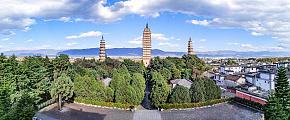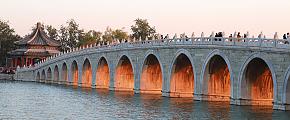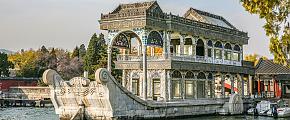Chinese Architectures - Pavilions, Terrace, Storeyed Building, Waterside Pavilion
Pavilions
A common sight in the country, the Chinese pavilion (ting, which also means a kiosk) is normally built either of wood stone or bamboo and may be in any of several plan figures - square, triangle, hexagon, octagon, a five-petal flower, a fan and what not. But all pavilions described as ting have this in common: they have columns to support the roof but no walls. In parks or at scenic spots, pavilions are built on slopes to command the panorama or on the lakeside to create intriguing images of the water. They are not only part of the landscape but also belvederes from which to enjoy it.
 Liangting in Suzhou, Jiangsu Province
Liangting in Suzhou, Jiangsu Province
Pavilions also serve diverse purposes. The wayside pavilion is called Liangting (cooling kiosk) to provide weary wayfarers with a place for rest and shelter in summer from the sun. The "stele pavilion" gives a roof to a stone tablet to protect the engraved record of an important event. Pavilions also stand on some bridges or over water wells. In the latter case, dormer windows are built to allow the sun to cast its rays into the well, as it has been the belief that water untouched by the sun would cause diseases. Occasionally, one finds two pavilions standing side by side like twins. In modern times, kiosks (also called ting in Chinese) have been erected in urban areas as postal stalls, newsstands, or photographers' sheds for snapshot services.
Rare among pavilions are those built of bronze. The most celebrated of these is Baoyunge (Pavilion of Precious Clouds) in Beijing's Summer Palace. The entire structure, including its roof and columns, is cast in bronze. Metallic blue in color, it is 7.5 meters tall and weighs 207 tons. Elegant and dignified, it is popularly known as the "Gold Pavilion."
The largest pavilion in China is also in the Summer Palace. The ancient building, named Kuoruting (the Pavilion of Expanse), has a floor space of 130 square meters. Its roof, converging in a crown on top and resting on three rings of columns (24 round ones and 16 square ones), is octagonal in form and has two eaves. With all its woodwork colorfully painted, the pavilion looks at once poised and majestic, well in harmony with the surrounding open landscape.
"Flowing-Cup Pavilion"
This is a pavilion that used to serve as a place of recreation for men of letters. In the stone floor is cut a winding ditch to which water from a spring is channeled. Participants in the "flowing-cup" game would, in turn, fill a cup with liquor and set it "sailing" down the mini-canal. The man whose cup reached the end of the ditch without spilling would be a winner. On the other hand, a loser would be made to drink or compose a poem as a forfeit.
The game, according to another source, could be played in a different way. Players took their respective positions along the ditch. He, in front of whom the cup stopped, would be made to drink or chant a poem of his composition.
Emperor Qianlong (1711-1799), it is said, was a great enthusiast of this game. The "flowing-cup pavilion" built for the emperor still stands today in the Imperial Garden of the Forbidden City. Another pavilion of this type in Beijing is found at Tanzhe Temple. Although a poem (praising the pleasures of the game, ", especially on a rainy day when there is little else to entertain the visitors with") is still intact on its columns, yet, alas! there is now neither flowing water nor a cup. If the pastime should be revived with some modern variations-beer, lemonade, or tea instead of spirits, singing or telling a joke as the forfeit if the players are not poets-it would certainly arouse considerable interest.
Another famous "flowing-cup pavilion" is Lanting (Orchid Pavilion) in Shaoxing, Zhejiang Province, which was a favorite resort of the great 4th-century calligrapher Wang Xizhi (321-379) and his friends, who used to gather there for the game and poem recitals. The little stream which carried the sailing cup is still there to greet modern admirers.
Terrace
The tai was an ancient architectural structure, a very much elevated terrace with a flat top. Generally built of earth and stone and surfaced with brick, it was used as a belvedere from which to look into the distance. In fact, however, many a well-known ancient tai as we know it today is not just a bare platform but has some palatial halls built on top.
A good example in hand is the Round City of Beihai Park in Beijing. A terrace five meters high, it has, on its top space of 4,500 square meters, the main hall with side corridors.
The tai could be built to serve different practical purposes. It could be used as an observatory, for instance, the one near Jianguomen in Beijing, which, with its brass astronomical instruments, dates to the Ming and Qing dynasties. It could also be used militarily, like the beacon towers along the Great Wall, to transmit urgent information with smoke by day and fire by night. Also, on the Great Wall, there is a square tai at intervals of every 300 to 400 meters, from which the garrison troops kept watch. On the track of the ancient Silk Road can still be seen, here and there, ruins of the old defense fortifications in the form of earthen terraces.
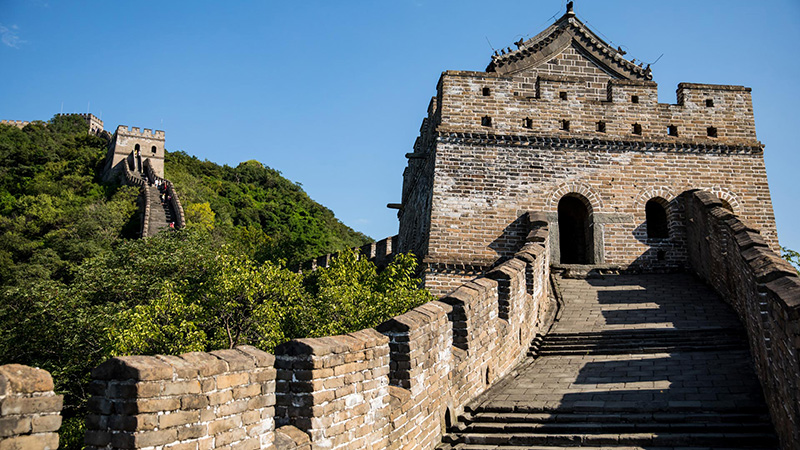 Tai of the Great Wall
Tai of the Great Wall
Storeyed Building
When the Chinese speak of a lou, they refer to any building of two or more stories with a horizontal main ridge.
The erection of such buildings began a long time ago in the Period of the Warring States (475-221 B.C.) when Chong Lou ("layered houses") was mentioned in historical words.
Ancient buildings with more than one storey were meant for a variety of uses. The smaller two-storeyed buildings of private homes generally have the owner's study or bedroom upstairs. The more magnificent ones built in parks or at scenic spots were belvederes from which to enjoy distant scenery. In this case, it is sometimes translated as a "tower." A Tang Dynasty poet, upon his visit to a famous riverside tower, composed a poem, two lines of which are still very much quoted: "To look far into the distance. Go up yet one more story".
Ancient cities had bell and drum towers (Zhong Lou and Gulou), usually palatial buildings with four-sloped, double-eaved, glazed roofs, all-around verandas, and colored and carved Dougong brackets supporting the overhanging eaves. They housed a big bell or drum, which was used to announce the time, and the local officials would open the city gates at the toll of the bell early in the morning and close them with the strike of the drum in the evening.
During the Ming and Qing dynasties (14th to 20th century), in front of each city gate of Beijing stood an archery tower, forming a barbican as a defense fortification. Two of them can still be seen today at the Qianmen and Deshengmen gates. Also, in Beijing, a "corner tower" still remains relatively intact at the southeastern corner of the old Inner City; it is put under state protection as a cultural relic, being the only one left in the ancient capital.
The art of constructing tall buildings was highly developed in China already in ancient times. Many multiple-storeyed towers of the complex structures had wholly wood frameworks fixed together with Dougong brackets without the use of a single piece of metal. Yueyang Tower in Hunan and Huanghelou (Tower of the Yellow Crane) in Wuchang are masterpieces among ancient towers.
Storeyed Pavilion
The Chinese Ge is similar to the Lou in that both are of two or more floors, but the Ge has a door and windows only on the front side, with the other three sides all solid walls, and it is usually enclosed by wood balustrades or decorated boards all around.
Such storeyed pavilions were used in ancient times for the storage of important articles and documents. Wenyuange, for instance, in the Forbidden City of Beijing was in effect, the imperial library. Kuiwenge, in the Confucius Temple of Qufu, Shandong Province, was devoted to the safekeeping of the books and works of painting and calligraphy bestowed by the courts of various dynasties. Visitors to the city of Ningbo, Zhejiang Province, can still see Tianyige, which houses the greatest private collection of books handed down from the past. Monasteries of a large size normally have their own libraries built in the style of a Ge and called Canjing-ge to keep their collections of Buddhist scriptures. Some of the Ge, notably those erected in parks, like other pavilions or towers (Ting, Tai, and Lou), were used for enjoying the sights.
The name ge is also used to describe the towers that shelter the colossal statues one finds in some great monasteries. A prominent example is the Guanyinge of Dulesi Temple in Jixian County, Hebei Province. Twenty-three meters high and housing the huge idol of the Goddess of Mercy (Guanyin), it is the oldest existing multiple-storeyed structure of its kind in China. Built in the Liao Dynasty (907-1125 A.D.), it has withstood twenty-eight earthquakes, including three of a devastating nature.
When all the houses in the area collapsed, it was the only one that survived the disaster. This goes to show how well its wood frame was structured. Other well-known religious buildings housing Buddhist statues, big or small, include Foxiangge in Beijing's Summer Palace, Dashengge in Chengde's Puningsi Temple, and Zhenwuge in Ronxian, Guangdong Province. All of them, tall, graceful, and dignified, can be listed as representative works of classical Chinese architecture.
Waterside Pavilion
One of the structures in traditional Chinese landscape gardening is the xie, a special form of the pavilion. The earliest Xie referred to the wood houses built on high terraces, but with the change of taste, it became more and more the fashion in later epochs to build the single-storeyed Xie on the shore of lakes or ponds.
It is the special feature of the Shuixie (waterside pavilion) to be rectangular or near the square in plan figure, half erected on land and half over water supported by stone pillars driven into the lake bottom. This structure is walled not with bricks but with wood frames with fancy windows on all sides. The side of the water is bordered with railings and equipped with seats, fixed or movable, to provide visitors with a vantage point to feast their eyes on the scenes of the lake.
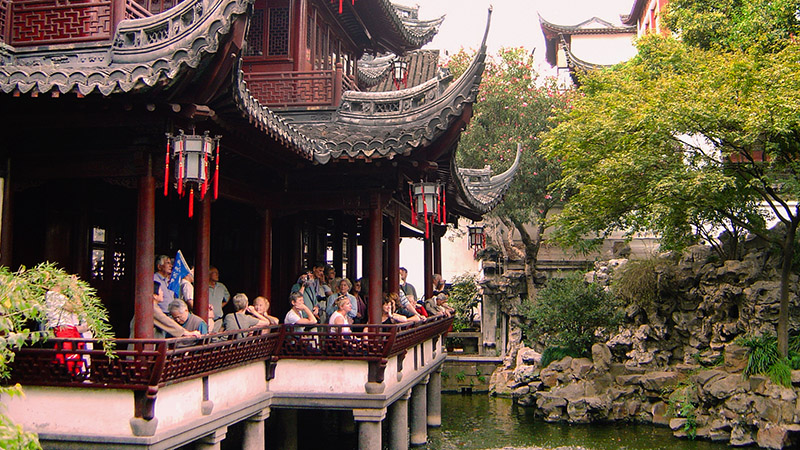 Waterside Pavilion in Yu Garden, Shanghai
Waterside Pavilion in Yu Garden, Shanghai
A typical example of this structure is the waterside pavilion in Xiequ Garden (Garden of Harmonious Interest) of the Summer Palace, from which Cixi, the all-powerful Empress Dowager of the late Qing Dynasty, is said to have enjoyed herself fishing.
Other well-known buildings of the same style include Furongxie in Zhuozheng Yuan (the Humble Administrator's Garden) of Suzhou, Shuixie in the Zhongshan Park of Beijing, and Shuixinxie in the Mountain Resort of Chengde.
House of Retreat
Certain types of Chinese buildings or rooms that provide or promise a quiet retreat for specific purposes are usually called zhai. This is originally a word with religious implication, meaning "purification by ablution and abstinence." From this has been derived the name Zhaigong (palace of purification), a special housing complex where the mind and body were "purified" in preparation for sacrifice or other solemn ceremonies.
Such a Zhaigong still stands on the precincts of Beijing's Temple of Heaven, inside its western entrance on the righthand side.
The emperors of the Ming and Qing dynasties, before they presented themselves at the annual rites of Heaven worship, used to stay there to bathe themselves and observe abstinence from pleasures. During this period of preparation, there would be no banqueting, no music, no drinking; no criminals would be tried, or punishments meted out. This palace attached to the temple is of considerable size. In a compound of more than 40,000 square meters stand the main halls, living quarters for the emperor, a drum tower, and a number of supporting buildings, totaling over 60 rooms. The magnificent structures, defended by two moats and bordered by a long corridor of 161 bays, make up the largest palace of its kind in the country.
In private houses, the rooms used for studies or for the keeping of books are called Shuzhai or "book chambers". All Zhai, whether devoted to religious activities or intellectual pursuits, were built as a rule in quiet, secluded spots, away from the sightseeing areas, sometimes with enclosure walls of their own. In Beijing's Beihai Park, for instance, there is a "garden within a garden" called Jingxinzhai or the Tranquil Heart Studio. Covering an area of 4,700 square meters, this peaceful place with houses of a distinctively graceful style used to be frequented by Emperor Qianlong when he wanted to do some serious reading or pursue quiet pleasures. Other examples par excellence among buildings described as zhai are Juanqinzhai (Studio of Relaxation) of the Qianlong Garden and Yangxinzhai (Studio of Metal Cultivation) of the Imperial Garden, both in the Forbidden City.
Studio
This is usually a simple but elegant structure built in parks or gardens to give an embellishing touch to the landscape. It is called Xuan after the name of a high-fronted, curtained carriage used in ancient times by people of rank, probably because, like the carriage, it is also high in the front and airy and spacious inside.
Architecturally, the Xuan is rather similar to the ting (pavilion), and both are used to adorn the scenic views either standing on the side of a lake or nestling on the slope of a mountain. The difference between the two is that the xuan is larger in size, more closed, and normally rectangular in plan, whereas the smaller ting always has a pointed round roof and no walls; the xuan is simply furnished with some tables and chairs so that people may sit down for a cup of tea, play a game of Weiqi or appreciate works of art, whereas the ting is as a whole devoid of furniture.
The word Xuan occasionally appears in the name of a teahouse or a restaurant. A well-known example is Laijinyuxuan (Come New Friends Studio) in Beijing's Zhongshan Park. Established in 1914, it operated at the beginning as a teahouse and snack bar. Lu Xun, the great writer used to frequent it to have tea, read newspapers and meet friends. The present Laijinyuxuan is a restaurant specializing in Sichuan and Jiangsu cuisine.
Among other structures representative of this style of architecture, imperial or private, one should count Xieqiuxuan (Paint Autumn Studio) in Beijing's Summer Palace and Zhuwaiyizhixuan (Lone Bamboo Outside the Grove) in Suzhou's Wangshiyuan (Master-of-nets Garden).
Covered Corridor
The covered corridor represents a typical architectural style in Chinese landscape gardening. A long, belt-like structure, it is a roofed walk with low railings or long side benches. Providing people with shade from the sun and protection from the rain not only adds beauty to the general scenery but plays a useful role as well.
Chinese covered corridors fall into many varieties, but roughly, they may be divided into Youlang, which links two or more buildings, Gulang (the zigzag corridor), and huilang (the winding corridor). Hualang is used for the display of potted flowers, and shuilang borders on lakes or goes over ponds.
It is the general consensus that the top of all classical corridors must be listed by any standards. The Long Corridor in Beijing's Summer Palace is a unique treasure in the art of gardening arrangement. An exquisite winding structure of 728 meters, it stretches its 273 bays between the hill and the lake, broken at intervals by four double-eaved, octagonal pavilions, which represent the four seasons of the year. All its beams are painted with colored pictures of landscapes, human figures, flowers, birds, and scenes of historical and popular stories. These paintings total more than 40,000 in number, and the visitor would need eight hours just to linger two seconds before each picture.
The Long Corridor, it is said, was built by Emperor Qianlong of the Qing Dynasty in order that his mother might safely enjoy the scenes of rain or snow over the lake. In effect, it is a piece of ingenious engineering that at once divides and links up the hill and the lake of the Summer Palace. Whether one looks at the lake from the hill or at the hill from the lake, the Long Corridor is always there, not only a pretty frame border for a nice picture but a colorful belt to bind the two parts together.
Famous private Chinese gardens, located mostly in the southern provinces, likewise, are often ornamented with corridors. In Suzhou's Zhuozhengyuan (The Humble Administrator's Garden), part of the winding corridor is erected over a pond and has been described as a "rainbow over water." With its reflection in the water, sometimes ruffled by a breeze, it is a favorite spot for visitors to take snapshots of themselves. In Liuyuan (The Lingering Garden), another well-known garden of Suzhou, the buildings-pavilion, terrace, hall, tower, etc.-break, and at the same time are linked by a 600-meter-long corridor. Its walls have fancy cut-through windows that reveal scenes on the other side, and they are also inset with 300 stone engravings of calligraphical works and poems by famous masters; both the windows and the engravings are regarded as masterpieces of their respective kinds. Visitors come here either to feast their eyes on the natural views or on the works of art and poetry, all of their choice.
Patterned Footpaths
On a stroll through a Chinese garden or park, one often finds oneself walking on footpaths of colored pebbles arranged in patterns - a feature of Chinese landscape gardening.
These patterned paths are not designed by architects but made by artisans from beginning to end. The paving of pebbles is a complicated job calling for skill and experience. First, lime mortar is spread out as the foundation layer, then the designs are outlined by means of plain and roofing tiles set in the mortar. On this is spread a special putty made of lime, wheat flour, and tung oil, on which again are fixed the pebbles of various natural colors - green ones for plant leaves, black ones for animals' eyes, and so on. The designs include all the usual subjects of traditional Chinese painting: landscapes, figures, flowers, birds, and historical and popular legends.
The best of patterned footpaths in China are found in the Imperial Garden in the rear of the Forbidden City. The colored pebbles there make up pictures under such familiar titles as "Magpie Announcing the Spring", "Dragon and Phoenix", "Cranes in Clouds", "Guan Gong Felling an Enemy", "Two Greybeards Watching a Game of Chess," and so forth, which symbolize good luck, victory, longevity and the like.
On the whole, patterned paths are found more often in parks and private gardens in the southern provinces than in the north. Prominent in this respect are the gardens in Suzhou, where the designs on pebbled paths display a wide range of subjects. Some are just geometric patterns, for instance, a square inside a circle like an ancient copper coin, signifying the old belief that "heaven is round and earth square." Others are in the forms of bats and cranes, Chinese symbols for good fortune and long life. Still, others are patterned after the fishing net, expressing perhaps the general wish for affluent abundance.
Quick Question
What Our Clients Say
"Great Customized Service", "Trip of A Lifetime", "Exceed All Expectations"
SUBSCRIBE TO WIN A FREE TOUR
Subscribe to our newsletter for a chance to win a free 7-day India tour! And more insider travel news, exclusive offers, and inspiration will be sent straight to your inbox.


